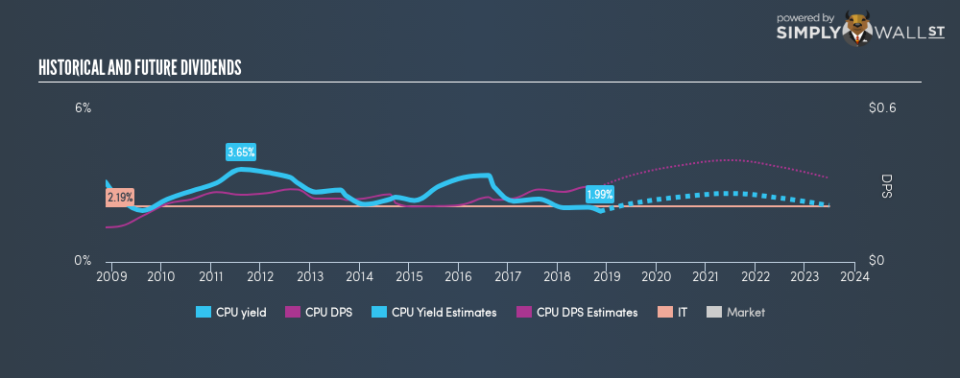Is Computershare Limited (ASX:CPU) A Smart Choice For Dividend Investors?

A sizeable part of portfolio returns can be produced by dividend stocks due to their contribution to compounding returns in the long run. Historically, Computershare Limited (ASX:CPU) has paid dividends to shareholders, and these days it yields 2.0%. Let’s dig deeper into whether Computershare should have a place in your portfolio.
Check out our latest analysis for Computershare
5 checks you should do on a dividend stock
When researching a dividend stock, I always follow the following screening criteria:
Is their annual yield among the top 25% of dividend payers?
Does it consistently pay out dividends without missing a payment of significantly cutting payout?
Has the amount of dividend per share grown over the past?
Does earnings amply cover its dividend payments?
Based on future earnings growth, will it be able to continue to payout dividend at the current rate?
How does Computershare fare?
The current trailing twelve-month payout ratio for the stock is 54%, which means that the dividend is covered by earnings. However, going forward, analysts expect CPU’s payout to fall to 48% of its earnings, which leads to a dividend yield of around 2.5%. However, EPS should increase to $0.64, meaning that the lower payout ratio does not necessarily implicate a lower dividend payment.
When considering the sustainability of dividends, it is also worth checking the cash flow of a company. Cash flow is important because companies with strong cash flow can usually sustain higher payout ratios.
If dividend is a key criteria in your investment consideration, then you need to make sure the dividend stock you’re eyeing out is reliable in its payments. Whilst its per-share payments have increased during the past 10 years, there has been some hiccups. Shareholders would have seen a few years of reduced payments in this time.
Compared to its peers, Computershare generates a yield of 2.0%, which is on the low-side for IT stocks.
Next Steps:
Taking all the above into account, Computershare is a complicated pick for dividend investors given that there are a couple of positive things about it as well as negative. However, if you are not strictly just a dividend investor, the stock could still offer some interesting investment opportunities. Given that this is purely a dividend analysis, I recommend taking sufficient time to understand its core business and determine whether the company and its investment properties suit your overall goals. There are three essential aspects you should further research:
Future Outlook: What are well-informed industry analysts predicting for CPU’s future growth? Take a look at our free research report of analyst consensus for CPU’s outlook.
Valuation: What is CPU worth today? Even if the stock is a cash cow, it’s not worth an infinite price. The intrinsic value infographic in our free research report helps visualize whether CPU is currently mispriced by the market.
Dividend Rockstars: Are there better dividend payers with stronger fundamentals out there? Check out our free list of these great stocks here.
To help readers see past the short term volatility of the financial market, we aim to bring you a long-term focused research analysis purely driven by fundamental data. Note that our analysis does not factor in the latest price-sensitive company announcements.
The author is an independent contributor and at the time of publication had no position in the stocks mentioned. For errors that warrant correction please contact the editor at editorial-team@simplywallst.com.

 Yahoo Finance
Yahoo Finance 
